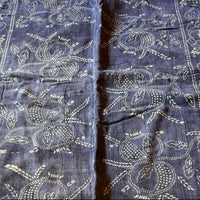

Antique Indigo Katazome Futon-ji – Dual Border Arabesque, 3 Panels Wide
A richly patterned antique futon-ji—a traditional futon cover made by sewing together narrow handwoven panels of cotton. This indigo piece features an elegant dual-border arabesque motif: scrolling vines, flower clusters, and rhythmic dotted work that together create a balanced, architectural frame around the central field. The patterning is lively but orderly, typical of katazome work from rural regions before industrial printing became widespread.
The textile was dyed using katazome, a Japanese resist-dye process in which artisans apply a rice-paste resist through hand-cut stencils (katagami). After the paste dries, the cloth is dipped repeatedly into natural indigo vats. When washed, the paste lifts away to reveal light, crisp patterning against a deep indigo ground. The subtle irregularities in tone and stencil alignment are hallmarks of hand production and lend each futon-ji its own personality.
This futon-ji is constructed from three hand-sewn panels, a size often used to cover a single tatami mat. Bedding was spread out each night and folded each morning, so these long, narrow futon covers were designed to withstand daily use, airing, and occasional repair.
This example shows the gentle aging we expect from everyday Showa-era textiles: softened indigo, mild creasing from storage, and faint marks of past seams. It does not show significant mending or structural damage, and still has excellent life left—whether displayed as a wall hanging, used as a table covering, or cut thoughtfully for patchwork, quilting, or visible mending projects.
This textile is an antique, likely 1920s–1940s (late Taishō to early–mid Shōwa period). We base this estimate on the handwoven cotton, traditional katazome technique, the panel construction width (~13.5–14" loom width), and characteristic household patterns common before the post-war industrial shift. The cloth shows age-appropriate fading and wear but lacks the heavy degradation common in earlier Meiji pieces.
- Katazome-dyed cotton with traditional end border
- Clear resist detailing and even patterning
- Subtle age patina; no major holes or repairs visible
- Ideal for textile study, quilting, or home decor
Dimensions: 39" × 82.75" (99 × 210 cm)
Panels: 3 panels wide (Determined from standard hand-woven loom widths of ~13.5–14", minus seam allowances.)
Made in Japan


